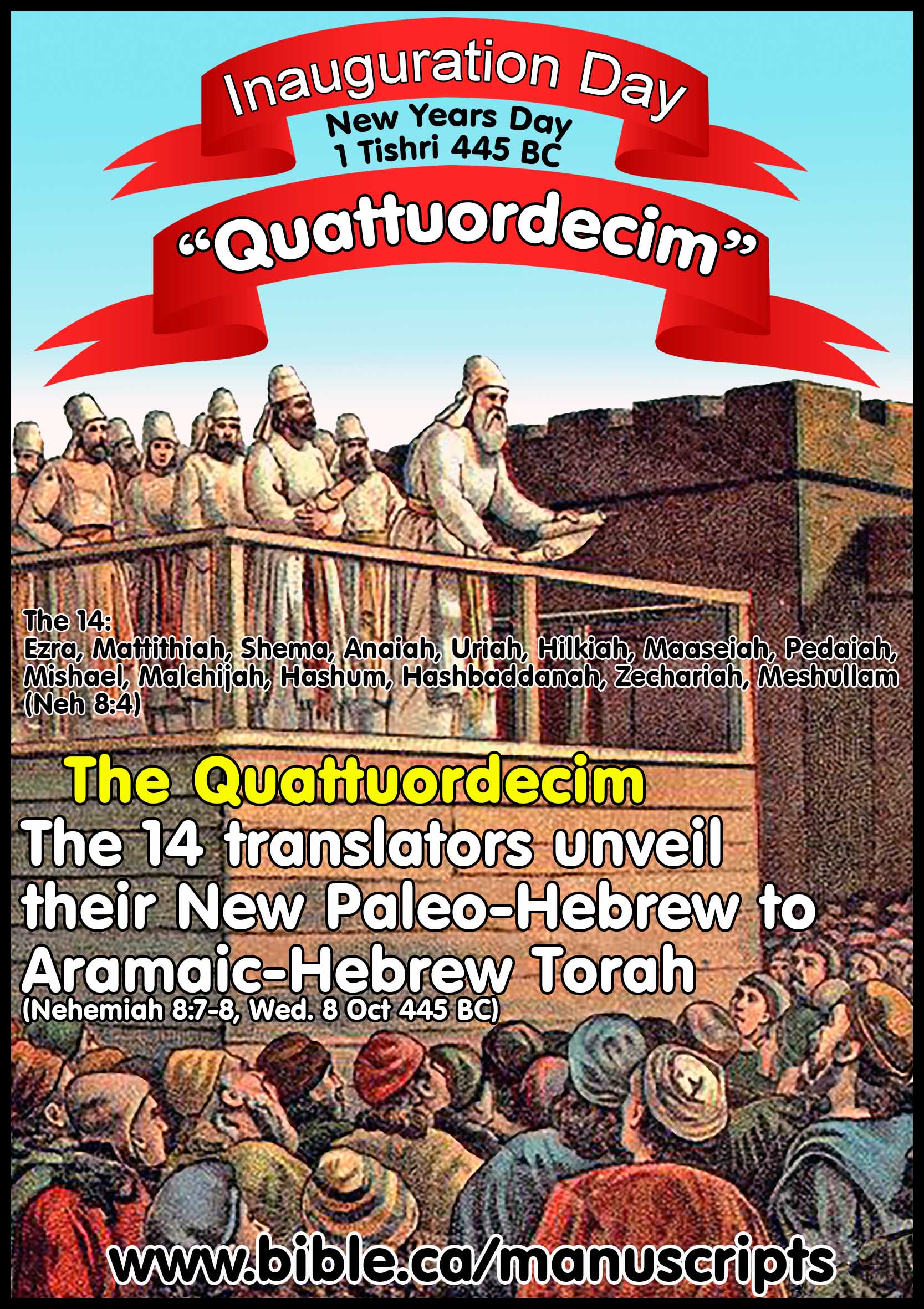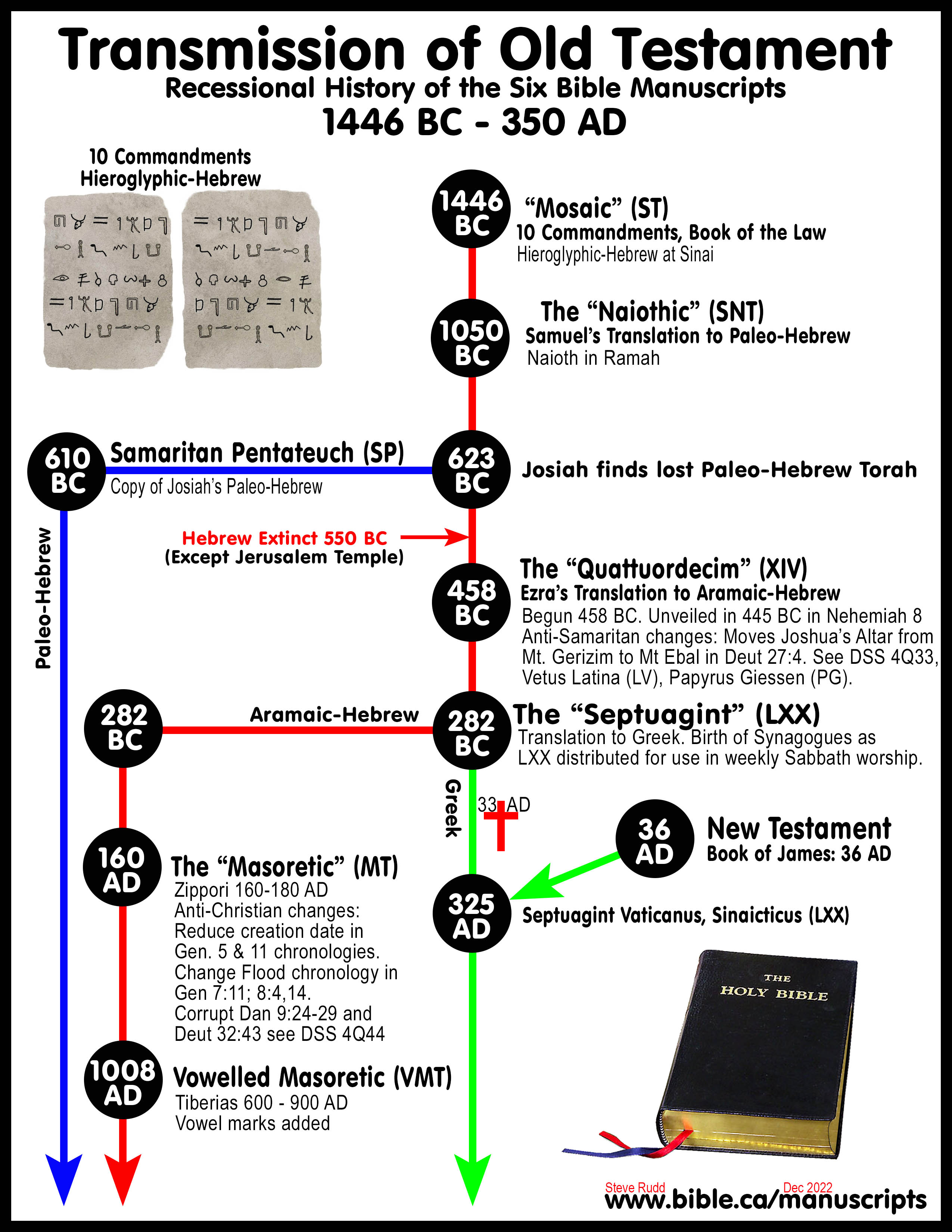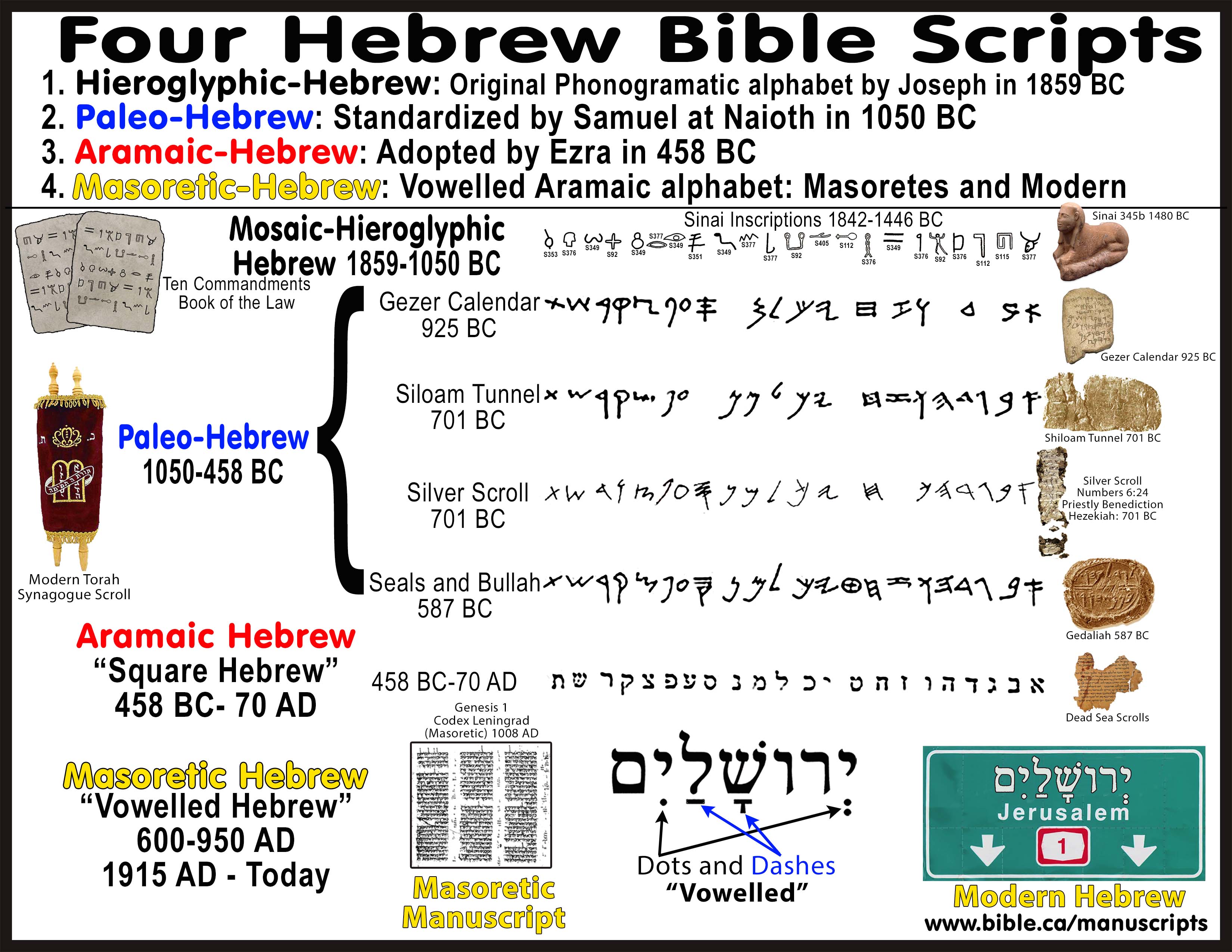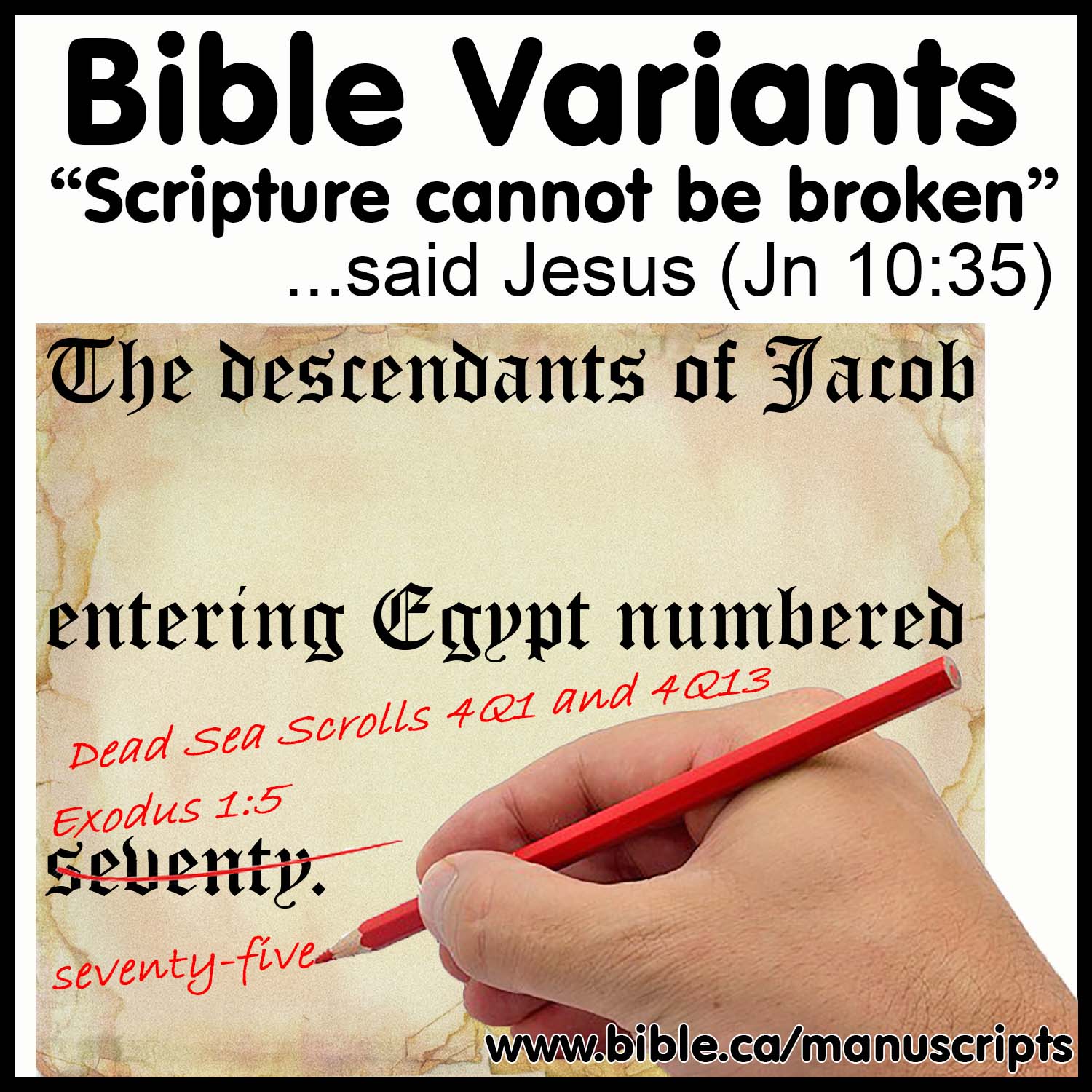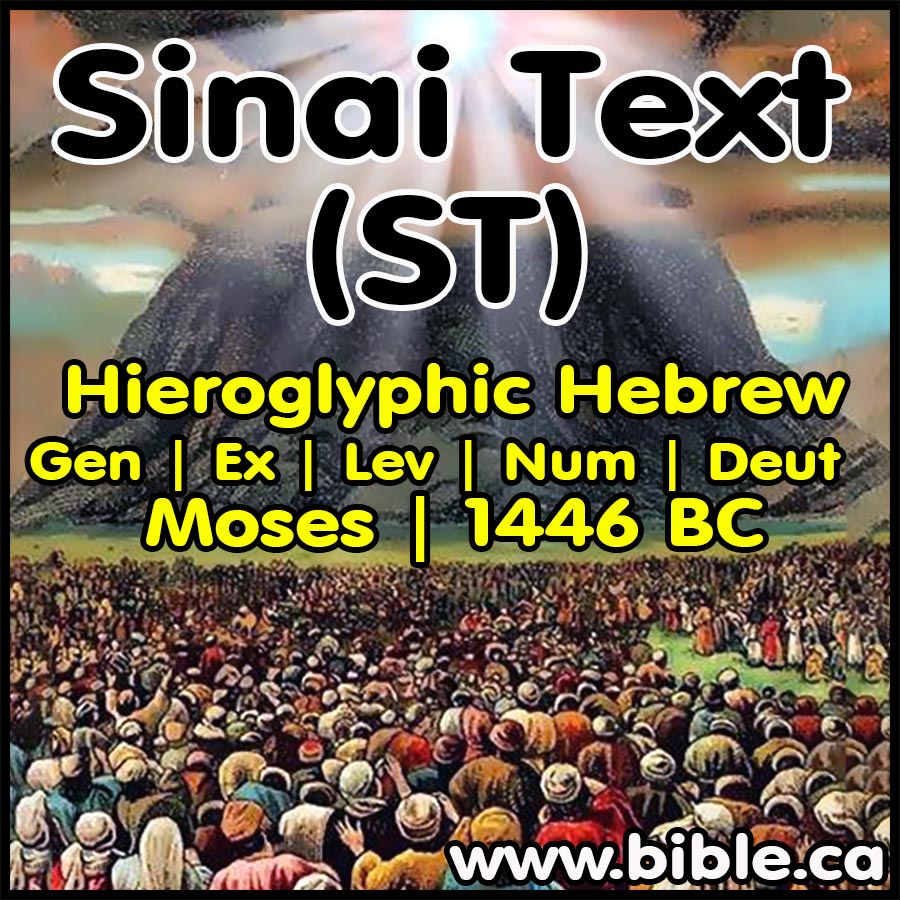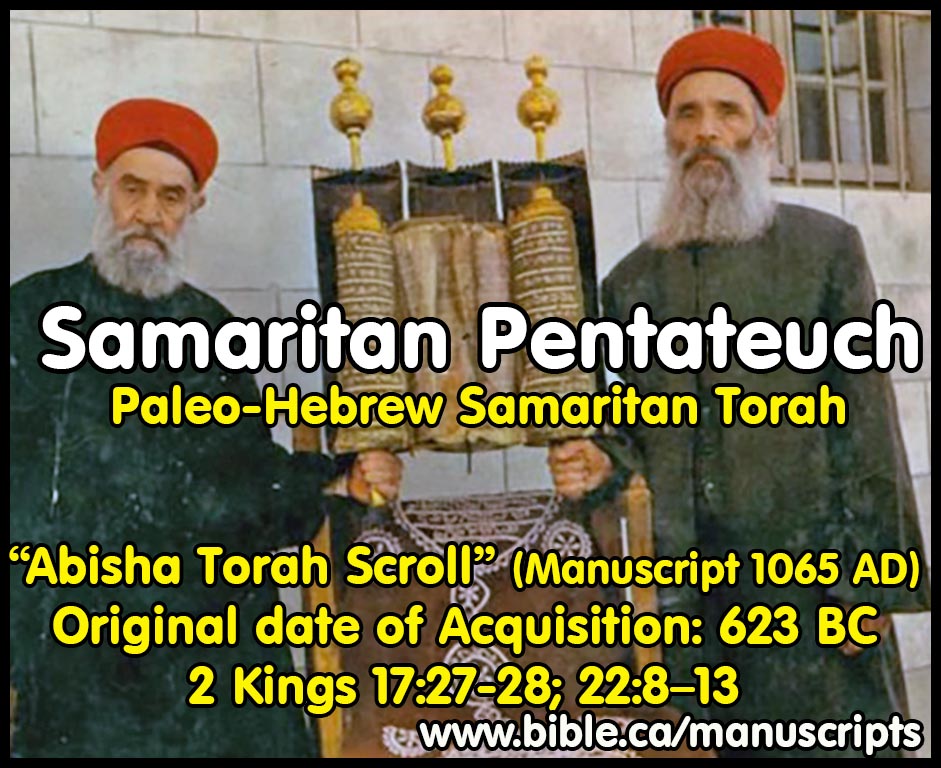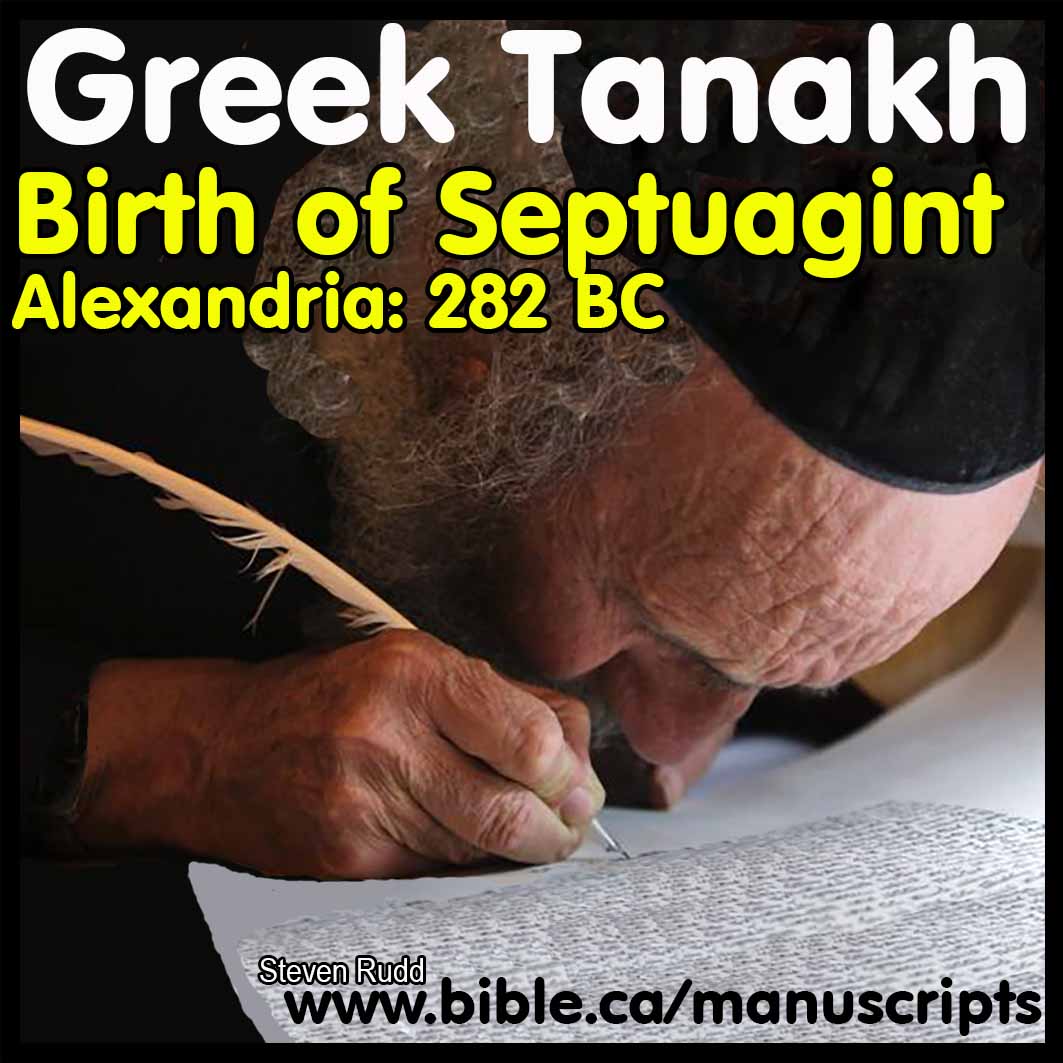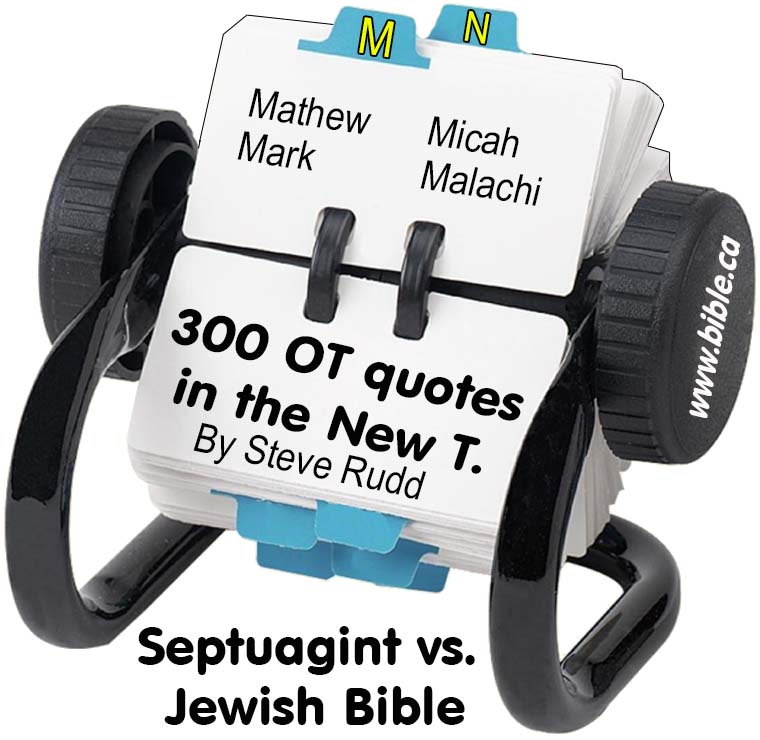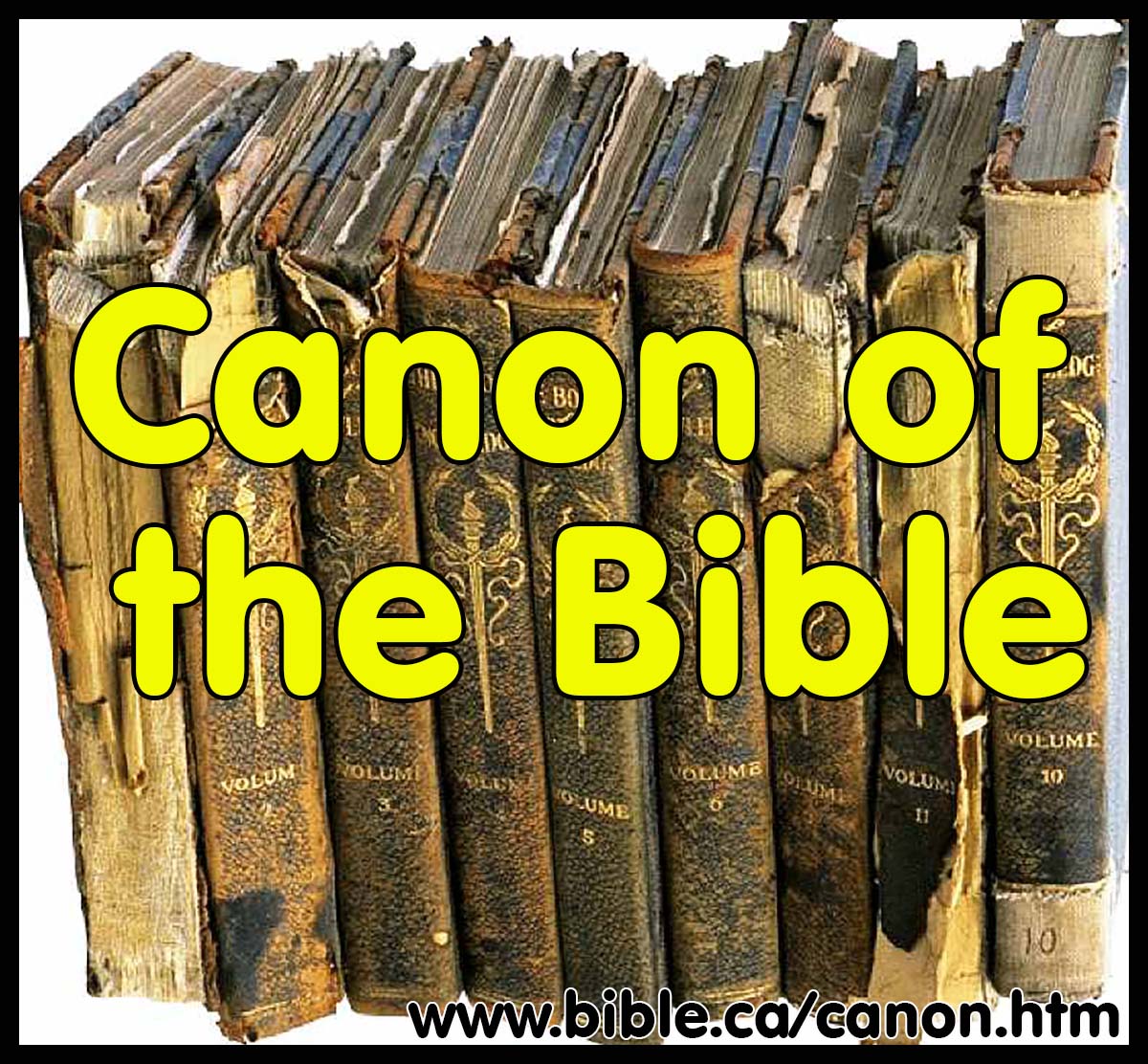“The Quattuordecim (XIV) of Ezra”
Translation started: 458 BC
Unveiled New Year’s Day 1st Tishri 445 BC
“Ezra the priest, the scribe of the law of the God of heaven” (Ezra 7:12)
Ezra’s Translation of Bible manuscripts from Paleo-Hebrew into Aramaic-Hebrew
Ezra’s Anti-Samaritan corruptions in the Hebrew Bible
"Scripture cannot be broken" (Jesus, John 10:35)
Steve Rudd 1017
Quick links inside this document:
1. Preamble: Must read!
2. Introduction
3. Babylonian destruction of Paleo-Hebrew scripture manuscripts in 587 BC
4. Literary sources that Ezra produced a new set of Bible manuscripts: “Quattuordecim (XIV)”
5. Samaritan Chronicle Adler charges Ezra with corrupting the Torah
6. “Great Library of Nehemiah”
7. Ezra’s Anti-Samaritan Variants in the Quattuordecim (XIV)”
a. Ezra’s Variant: Deut 27:4: Joshua’s Altar on Mt. Gerizim
b. Ezra’s Variant: Change of tense from past “has chosen” to future “will chose”
c. Ezra’s Variant: Lev 26:31 change of singular “sanctuary” to plural “sanctuaries”
d. Ezra’s Variant: Deut 11:30 Deleted words “opposite Shechem”
8. Conclusion
Ezra’s Quattuordecim (XIV)
Autograph manuscript of Hebrew pre-Masoretic text
458-445 BC
Notice that Ezra the priest is called, “the scribe of the law of the God” (Ezra 7:12) which is a direct confirmation that Ezra was involved in the process of copying and transmitting scripture. The Quattuordecim (XIV) is the autograph copy of the Hebrew proto-Masoretic script from which the Septuagint and most of the Dead Sea Scrolls have their origin. The Quattuordecim was a conversion/translation of the Paleo-Hebrew Bible manuscripts into Aramaic “Square” Hebrew by 14 men starting in 458 BC until the official unveiling at a public reading on New years day 1 Nisan 445 BC. The result was a near perfect replica of the Paleo-Hebrew Tanakh, which the exception of 4 deliberate but minor anti-Samaritan changes in the text to counter their claim that Mt. Gerizim and not Jerusalem was God’s holy mountain. Here are the names of the 14 translators:
The 14 translators of the Quattuordecim:
Ezra, Mattithiah, Shema, Anaiah, Uriah, Hilkiah, Maaseiah, Pedaiah,
Mishael, Malchijah, Hashum, Hashbaddanah, Zechariah, Meshullam
(Nehemiah 8:4)
After Daniel surrendered to Nebuchadnezzar in 605 BC at the beginning of the 70 year captivity and after the destruction of Jerusalem in 587 BC and after the decree of Cyrus to return to Jerusalem to rebuild the temple in 536 BC and after the decree of Artaxerxes II to rebuild the city walls in 458 BC the Jewish world that Ezra the scribe found himself in had changed dramatically. Hebrew was functionally extinct among the general population of Jews who now spoke Aramaic. Ezra was one of a tiny minority who were bilingual and could still read and write in native Hebrew. To make matters worse, the Hebrew speaking Jews dropped the use of the Paleo-Hebrew script and instead began spelling their Hebrew words out in the Aramaic alphabet. So, of the few who still spoke Hebrew, only a fraction of them could read and write in Paleo-Hebrew script. In 458 BC, Ezra was in possession of ALL the best bible manuscripts but they were written in Samuel’s Paleo-Hebrew text script and were not much use. Contrary to some historic sources, we know Nebuchadnezzar was in possession of the Bible scrolls because Daniel was able to pull out the Isaiah scroll and show Cyrus where his name was prophesied 150 years earlier in Isa 45:1. Starting in 458 BC, Ezra and with the help of 13 other men, undertook to translate the extant Bible manuscripts of the Old Testament into the “Aramaic-Hebrew” (Square Hebrew) script. We call it the “Quattuordecim” since 14 men did the translation work. It was still native Hebrew language not Aramaic language, he simply substituted the Aramaic alphabet for the Paleo-Hebrew letter for letter, sound for sound. When he was done, only Samaritans were still using the Paleo-Hebrew Torah scrolls at Mt. Gerizim. Ezra’s new Bible manuscripts are the “autograph” copies of all subsequent Bible manuscripts found in the Dead Sea Scrolls and the Masoretic Text of 1008 AD. They are also the Hebrew source text behind the “Septuagint” that was translated into Greek in 282 BC in Alexandria. When Ezra walked out in 458 BC with his new set of Bible manuscripts the general population could still not read them and had to trust by faith, that the work of Ezra was correct.
Inauguration day: Ezra unveils his new “Quattuordecim” Torah in Aramaic (square) Hebrew:
On New years Day, Wednesday October 8, 445 BC Ezra, flanked by the other 13 translators, had a grand unveiling of the brand new Quattuordecim translation:
"And all the people gathered as one man at the square which was in front of the Water Gate, and they asked Ezra the scribe to bring the book of the law of Moses which the Lord had given to Israel. Then Ezra the priest brought the law before the assembly of men, women and all who could listen with understanding, on the first day of the seventh month. He read from it before the square which was in front of the Water Gate from early morning until midday, in the presence of men and women, those who could understand; and all the people were attentive to the book of the law. Ezra the scribe stood at a wooden podium which they had made for the purpose. [The 14 translators:] And beside him stood Mattithiah, Shema, Anaiah, Uriah, Hilkiah, and Maaseiah on his right hand; and Pedaiah, Mishael, Malchijah, Hashum, Hashbaddanah, Zechariah and Meshullam on his left hand. Ezra opened the book in the sight of all the people for he was standing above all the people; and when he opened it, all the people stood up. Then Ezra blessed the Lord the great God. And all the people answered, “Amen, Amen!” while lifting up their hands; then they bowed low and worshiped the Lord with their faces to the ground. Also Jeshua, Bani, Sherebiah, Jamin, Akkub, Shabbethai, Hodiah, Maaseiah, Kelita, Azariah, Jozabad, Hanan, Pelaiah, the Levites, explained the law to the people while the people remained in their place. They read from the book, from the law of God, translating to give the sense so that they understood the reading." (Nehemiah 8:1–8, )
We can be certain that Hebrew is extinct among the Jews as a working language except for a tiny remnant of the population in 445 BC because of two key statements:
1. “all who could listen with understanding” Neh 8:2-3 (The tiny remnant who could listen to the Hebrew reading and understand)
2. “translating to give the sense so that they understood the reading” Neh 8:8 (The general public who needed the Hebrew translated)
Ezra makes Anti-Samaritan changes to the Hebrew Text:
Another important dynamic are the Samaritans who had acquired a copy of Josiah’s Paleo-Hebrew Torah which he found in 623 BC.
“There is no doubt that this distinct version of the Israelite Samaritan Torah originated during the most ancient period of the people of Israel.” (The Israelite Samaritan version of the Torah, Benyamim Tsedaka, p xxi, 2013 AD)
The Samaritans had undergone a mass conversion to monotheism around 540 BC and with sincere zeal and pure hearts, offered to help Ezra rebuild the Jerusalem temple in 533 BC. Here are their exact words: “Let us build with you, for we, like you, seek your God; and we have been sacrificing to Him since the days of Esarhaddon king of Assyria, who brought us up here.” When they were rejected and insulted by Ezra, they morphed into his arch enemy ran off and built their own temple on Mt. Gerizim and began to oppose the Jews. In other words, Ezra created his own enemy in that the Samaritans were first hurt, then angry. Yes, the Samaritans knew they were a “half-breed” mix Jew and Assyrian, but they wanted to worship the one true God with the same pure heart as Ezra. After 17 turbulent years of opposition from their “enemies” (Samaritans, Ammonites and the locals) the Jew finally completed their Jerusalem Temple in 516 BC. With the decree of Artaxerxes II in 458 BC to rebuild the Jerusalem city walls (Ezra 7:8-26), Ezra begins to intensely study the word of God and determines it needs to be converted from the obsolete Paleo-Hebrew script of Samuel the prophet into the Aramaic script now common among the Jews.
"For Ezra had set his heart to study the law of the Lord and to practice it,
and to teach His statutes and ordinances in Israel." (Ezra 7:10)
The Quattuordecim is born: In 458 BC Ezra makes the long trip from Babylon to Jerusalem and begins work translating the Paleo-Hebrew scriptures into the Hebrew script that will be used by Jesus and in the modern state of Israel today. The translation process for all the extant books of the law and prophets is a monumental task and is not completed until the official unveiling in 445 BC.
Ezra’s 4 minor changes to the Hebrew text to counter Samaritan theology:
Ezra knows the Samaritans are wrong whey they venerate Mt. Gerizim over Jerusalem as God’s holy temple. But he is seriously annoyed by their new temple on Mt. Gerizim and tormented daily by their ceaseless opposition to the Jews. The thing that irked Ezra the most, was that the Samaritans were quoting three passages in their Paleo-Hebrew Torah (the one they got from Josiah) as proof texts that their temple on Mt. Gerizim venerated Joshua’s Altar. Using Deut 27:4, the Samaritans argued that Joshua’s alter had been built on Mt. Gerizim and therefore was the holy mountain prophesied by Moses, not Jerusalem. While Ezra knew they were “twisting and contorting the word of God” he decided to put an end to this dispute once and for all by making 4 minor changes to the Hebrew text that are found in both the Septuagint and the Masoretic text today.
|
Summary of 4 anti-Samaritan changes made by Ezra in the Quattuordecim |
||
|
Text changed by Ezra |
Paleo-Hebrew Torah of Samaritans and Ezra |
Ezra’s Quattuordecim translation |
|
Deut 27:4 (Ezra change Gerizim to Ebal) |
Joshua will build an altar on Mt. Gerizim |
Joshua will build an altar on Mt. Ebal |
|
Deut 12:5,11,14 etc. 21 Texts total (Ezra changed to past tense) |
God “has chosen” [ie. Joshua’s Altar] a place for the name of God to dwell |
God “will chose” a place for the name of God to dwell |
|
Lev 26:31 (Ezra changed to plural) |
“sanctuary” (singular- ie. Joshua’s Altar) |
“sanctuaries” (plural- ie. Joshua’s altar, Shiloh, Jerusalem) |
|
Deut 11:30 (Ezra deleted opposite Shechem) |
“Mt Gerizim and Ebal are opposite Gilgal, beside the oak of Moriah opposite Shechem” |
“Mt Gerizim and Ebal are opposite Gilgal, beside the oaks of Moreh” |
Many ancient Jewish and Christian literary sources like 2 Maccabees, 2 Esdras, Irenaeus, Clement and the Samaritan Chronicle Adler, identify Ezra as producing a new set of Bible manuscripts. Samaritan Chronicle Adler (1900 AD) says that Ezra got his copy of the Paleo-Hebrew Torah from the Samaritans by deceit and he then deliberately made anti-Samaritan changes to the text.
“Whereupon Ezra used deceit to obtain an ancient torn Torah from a man who was one of the community of the children of Israel who were Keepers of the Truth… Ezra altered many things in the text of the Holy Torah out of hatred for the community of the children of Israel who are Keepers of the Truth (Samaritans), … adding some things and subtracting many others … many errors were made by him in the book of the Torah” (Samaritan Chronicle Adler, 1900 AD)
If Ezra did acquire his copy of the Torah from the Samaritans, it explains why he wrongly assumed that they had made textual changes regarding the location of Joshua’s Altar and Ezra then felt justified in “restoring” the original reading. However, the Samaritan storyline has two major flaws. First, If Nebuchadnezzar burned all the scripture scrolls, where did Ezra get the rest of the books from Joshua down to the prophets since the Samaritans deliberately avoided them? Second, if the copy was damaged, torn and missing sections of text it is unlikely Ezra would use it. Further, the fact that the MT and the SP are very close in text overall with no large lacunas of missing text, is evidence that Ezra had a complete and undamaged Torah to work from. If the Samaritans freely and openly supplied Ezra with the first five books of Moses (Torah) he would have been grateful and accepted their initial offer to help build the Jerusalem temple. The Samaritan Chronicle Adler correctly identifies Ezra as being involved in some significant way based upon some ancient Samaritan tradition but the details may have been lost over time.
Since all the Paleo-Hebrew manuscripts were in the hands of Ezra and his 13 assistant translators in a single location, in a general population that could not speak Hebrew, it was almost certain that the minor changes would ever be noticed. With the blatant change of the location of Joshua’s alter from Mt. Gerizim to Mt. Ebal, the other three changes were irrelevant and unnecessary. But Ezra was seriously irked by the Samaritans and he felt the changes in the Bible text were for the greater good in establishing Jerusalem as God’s holy mountain.
The death of Ezra in 445 BC at 120 years old:
Ezra the priest/scribe must have been over 30 years old in 536 BC because that is the age priests must be to serve. (Numbers 4:3, 23, 30, 35, 39, 43, 47) 90 years had elapsed from the decree of Cyrus in 536 BC to the unveiling of Ezra’s Quattuordecim in 445 BC. He unveiled his Quattuordecim in 445 BC when was about 120 years old. There is a synchronism between Ezra and Joshua living to be 120 years and the keeping of the Feast of Booths. Notice that 445 BC under Ezra, was the first time since Joshua, almost 1000 years earlier, that the entire nation celebrated the feast of Booth. (Solomon instituted the feast of booths, but it was only kept in Jerusalem, not the entire nation: 2 Chr 7:8; 8:13)
"The entire assembly of those who had returned from the captivity made booths and lived in them. The sons of Israel had indeed not done so from the days of Joshua the son of Nun to that day. And there was great rejoicing. Ezra read from the book of the law of God daily, from the first day to the last day. And they celebrated the feast seven days, and on the eighth day there was a solemn assembly according to the ordinance." (Nehemiah 8:17-18)
The Septuagint, Hebrew Dead Sea scrolls and the pre-Masoretic text
After the death of Ezra in 445 BC, 163 years would pass until in 282 BC a copy was made of Ezra’s “autograph copy” of the Quattuordecim (XIV) Torah (pre-Masoretic text) and sent to Alexandria where it was translated into Greek and the Septuagint (LXX). The Hebrew copies of the Quattuordecim (XIV) the Greek Septuagint (LXX) and the Samaritan Pentateuch (SP) were essentially identical except for the few places Ezra had changed the Bible text to counter Samaritan theology regarding the dispute between Mt. Gerizim and Jerusalem as the place God’s name was to reside. What we find remarkable, is that the Samaritan Pentateuch of today is closer to the Septuagint in many places than the modern Masoretic text of 1008 AD. The same is true of the Dead Sea scrolls which frequently validate the Paleo-Hebrew Samaritan Pentateuch (SP) and the Greek Septuagint (LXX). For example, the Hebrew (not Samaritan) Dead Sea Scroll 4Q33 Deuteronomyf (100 BC) reads that Joshua’s Altar was built on Mt. Gerizim. Evidently the Jews at Qumran had access to other ancient manuscripts outside the family of Ezra’s Quattuordecim (XIV) and retained the original reading.
|
|
1. The recent work by Douglas Petrovich in discovering that Hebrew was the first alphabet identified as “Hieroglyphic Hebrew” leads us to conclude that Israel has worked with four different scripts in their history from the time Jacob entered Egypt down to the present.
|
Three script changes in Hebrew: Mosaic-Hieroglyphic Hebrew script by Joseph in 1859 BC. Paleo-Hebrew script by Samuel in 1080 BC Aramaic-Hebrew “square” script by Ezra in 458 BC. Masoretic-Hebrew “vowelled” script by Masoretes in 600 AD. See full outline on the Four Hebrew Scripts |
a. More important, is the understanding that the script found in the Dead Sea scrolls is two scripts removed from the original script Moses used at Mt. Sinai.
b. With Archeology and the Bible, we can identify when Israel converted to each new scripts and who was the engine behind these changes.
2. There is a rich tradition that Ezra the scribe/priest restored and preserved the Bible manuscripts in his day:
a. 2 Maccabees 2:13–32, 124 BC
b. 2 Esdras 14:21-26, 90 AD
c. Irenaeus, Against Heresies 3.21.2, 180 AD
d. Clement of Alexandria, Misc. 1.22.149, 185 AD
e. Samaritan Chronicles 7, Adler, 16th Excerpt, The deceit of Zerubbabel, Nehemiah, and Ezra
3. While Ezra was bilingual, the Jewish population could not speak, read or write Hebrew. Instead they spoke Aramaic from the time of the captivity down to the first century in Judea.
a. Ezra was the sole top expert in sole possession of the paleo-Hebrew manuscripts, which only he could read.
b. Ezra translated the Paleo-Hebrew bible manuscripts into Aramaic Hebrew (Square) which still, only he could read, not the general population.
c. Note: Aramaic “square” Hebrew is the Hebrew language spelled using the Aramaic alphabet. It is the Hebrew language, no Aramaic. Ezra simply substituted the more common Aramaic alphabet for the more archaic paleo-Hebrew alphabet.
I. Babylonian destruction of Paleo-Hebrew scripture manuscripts in 587 BC
1. The Edomites burn the Temple (and possibly the bible scrolls) under Nebuchadnezzar in 587 BC:
a.
The Bible is silent on whether the Bible scrolls were burned at the time
of the Babylonian Captivity 587 BC. We do know that Nebuchadnezzar did remove
the holy vessels of gold and silver and put them into a store house. Whether he
also took the scrolls we do not know. What we do know, is that the great
scribes document storage room was burned and as a result the clay bulla were fired and discovered through
three dimensional archeological excavations in the city of David.
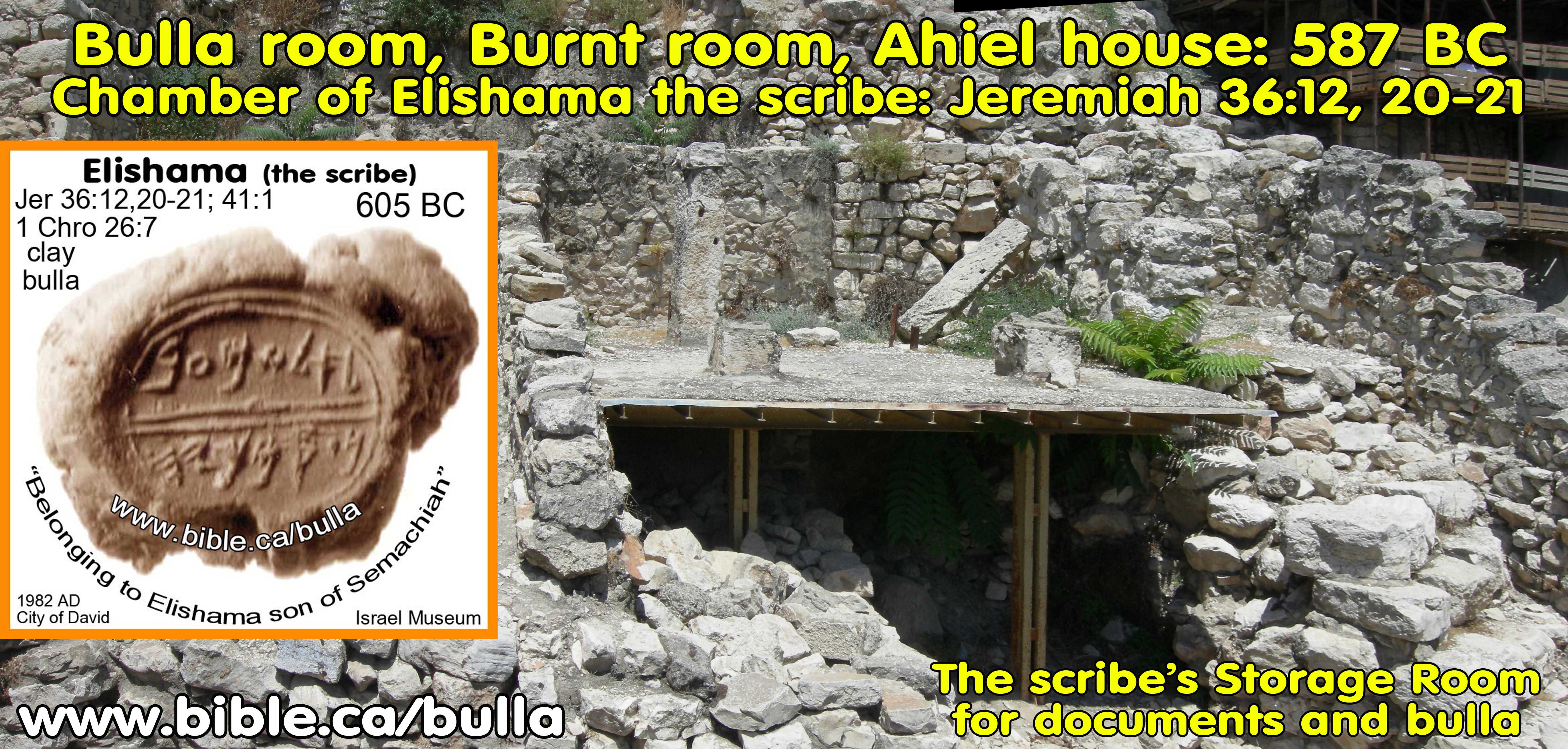
b. "And I answered and said: I pray thee, my Lord, wherefore, O my Lord, hath understanding been given me for thought? For I have not desired to ask about the way of what is above, but about those things which pass over us daily: for Israel is given up to the peoples (Babylonians in 587 BC), and the people thou hast loved is given up to godless tribes; and the holy Law of our fathers is set at naught, and the written covenants are no more; and we pass from the world as locusts, and our life is as a breath. We indeed are not worthy that mercies should come upon us;" (2 Esdras 4:22-24, 90 AD)
c. "Now on the seventh day of the fifth month, which was the nineteenth year of King Nebuchadnezzar, king of Babylon, Nebuzaradan the captain of the guard, a servant of the king of Babylon, came to Jerusalem. He burned the house of the Lord, the king’s house, and all the houses of Jerusalem; even every great house he burned with fire." (2 Kings 25:8–9)
d. "Now on the tenth day of the fifth month, which was the nineteenth year of King Nebuchadnezzar, king of Babylon, Nebuzaradan the captain of the bodyguard, who was in the service of the king of Babylon, came to Jerusalem. He burned the house of the Lord, the king’s house and all the houses of Jerusalem; even every large house he burned with fire." (Jeremiah 52:12–13)
e. "You [Cyrus] also vowed to rebuild the temple which the Edomites set on fire when Judah was devastated by the Chaldeans." (1 Esdras 4:45)
2. Later Jewish tradition (225 AD) of Torah Reading in Captivity (605-536 BC) contradicts the idea that Ezra under inspiration restored the Bible scrolls:
a. Torah Reading in Babylon contradicts the view that all Manuscripts were destroyed in 587 BC
b. “With the destruction of Jerusalem came the end of sacrifices, and the people of Judah found themselves in exile without this means of expiation and reconciliation with God. In spite of this gap in their spiritual life, the Jews survived as a nation since they returned to the Torah as the main purpose of their existence. With the earliest emergence of the synagogue during the Babylonian exile, the Torah assumed the central role in Jewish life, never to relinquish it again, even through Second Temple times, where it existed side by side with a re-emerging sacrificial ritual, but always looming greater in significance than the cultus. The greatest moment for the re-emergence of the Torah as the focal point in Jewish life, occurred about a century after the return to Judah during the time of Ezra. This reorganizer of the returned Jewish community from Babylonian exile, made the Torah the nucleus of his reconstructive efforts (Neh 8:1–18). Consequently, the Torah became so intricately linked to the Jewish people, that the nation was able to survive the disaster of 70 c.e and continue to remain united under the banner of Torah propagated at Yavneh and subsequently in the land of Israel, in Babylonia, and in other parts of the world up to the present day.” (The Aramaic Bible, The Targum Onqelos Translated with a Critical Introduction Apparatus and Notes, Bernard Grossfeld, Michael Glazier, Volume 6 to Genesis, p 2, 1988 AD)
3. Conclusion: Nebuchadnezzar did not burn the Bible scrolls:
a. If Nebuchadnezzar kept all the holy instruments from the temple, he would surely keep the Bible scrolls.
b. We know Nebuchadnezzar was in possession of the Bible scrolls because Daniel was able to pull out the Isaiah scroll and show Cyrus where his name was prophesied 150 years earlier in Isa 45:1.
c. This proves that the account in 2 Esdras 4:22-24 dated to 90 AD is not correct.
d. We find inscriptions of Assyrian Kings where they looked to the God’s to mention them by name. See translation of: Victory Stele of Esarhaddon “To Ashur, father of the gods, lover of my priesthood, Anu, mighty and pre-eminent, who called me by name” (Line one)
e. This would have greatly impressed Cyrus when Daniel called for the ancient scrolls in the vault to be brought out and there was his name!
f. This was likely the primary motivating factor in his proclamation to rebuilt the Jerusalem Temple from the famous “Cyrus Cylinder”.
g.
In other words, if Daniel just said, “Hey Cyrus, our prophet named you
150 years ago”. Cyrus would not have believe him. But seeing his name in the
scroll with his own eyes was a stunning confirmation.
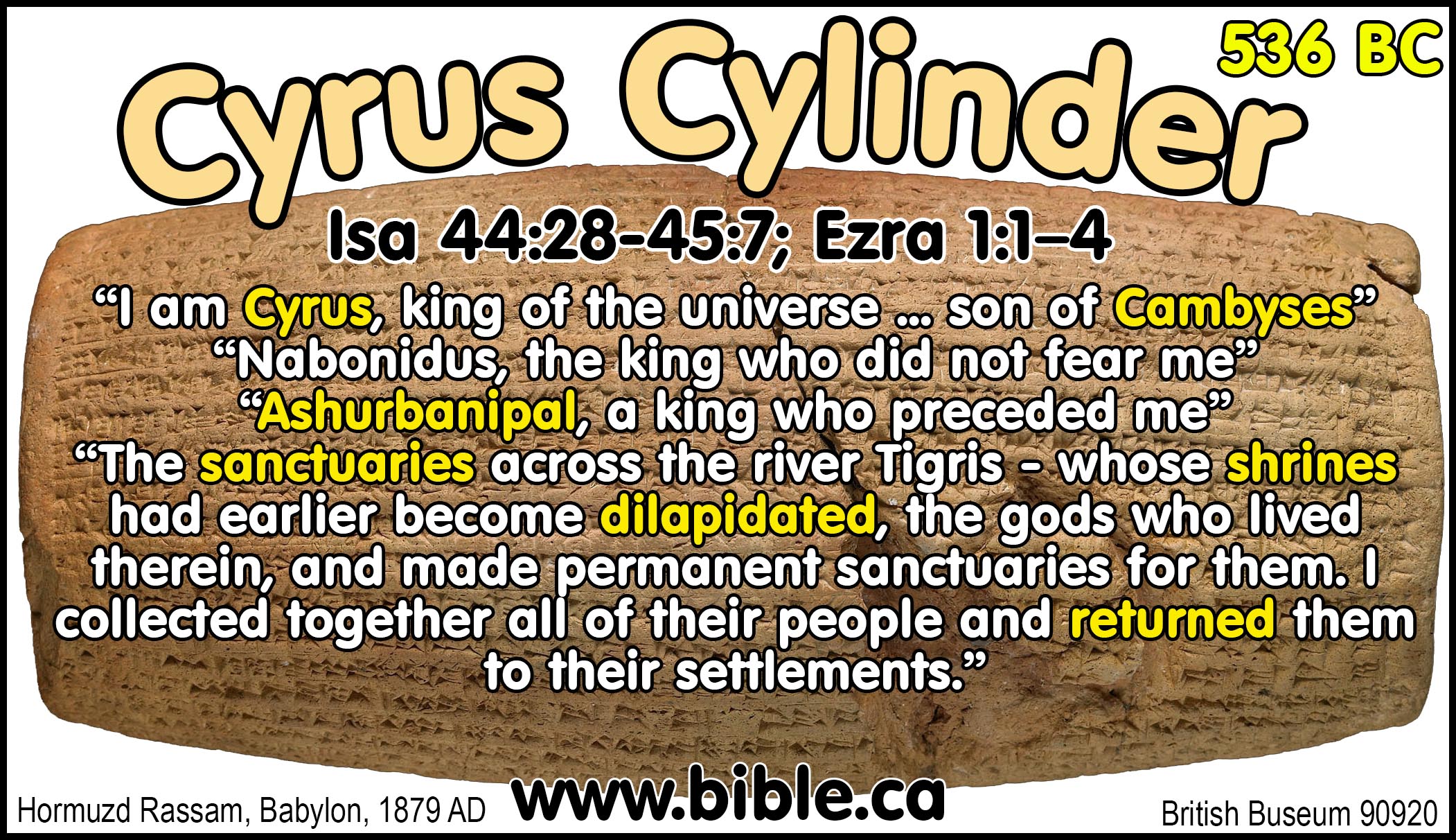
II. Literary sources that Ezra produced a new set of Bible manuscripts: “Quattuordecim (XIV)”
1. Literary sources for Ezra’s Quattuordecim:
a. 90 AD 2 Esdras 14:21-26: "For the Law is burnt (Nebuchadnezzar 587 BC), and no one knoweth the works that thou hast done, or what thou art about to do. If, then, I (Ezra) have found favour before thee, send into me, [Lord], the Holy Spirit, and I will write all that hath happened in the world, from the beginning everything that hath been written in thy Law, that men may be enabled to find the path, and that they who would live at the last may know the way. And he answered and said to me: Go and gather together thy people, and tell them not to seek thee for forty days. But do thou prepare for thyself many writing-tablets, and take with thee Seraia and Daria and Shelemia, together with Helkana and Shiel, these five men, because they are equipped for writing quickly; and thou shalt come hither and I will light in thine heart a lamp of discernment which shall not be extinguished until thou shalt complete what thou art about to write. And when thou shalt have finished, some of them thou shalt make public, and some thou shalt conceal, and shalt deliver them to the wise; [for] tomorrow at this time thou shalt begin to write." (2 Esdras 14:21-26, 90 AD)
b. 90 AD 2 Esdras 14:37-48: "And I took these five men as he had commanded me, and went into the field, and we remained there [as he had told me]. And it came to pass on the morrow, and lo! a voice called to me, and said: Ezra, [Ezra], open thy mouth and drink what I give thee to drink! And I opened my mouth and saw, (and lo!) there came to me a full cup, and it was full as it were (of) water, and its appearance was like fire. And I took and drank. And it came to pass when I had drunk it, lo! My heart overflowed with discernment, and my breast poured forth wisdom, and my spirit retained memory. And my mouth was opened and was not shut. But the Most High gave understanding to the five men, and they wrote the things that were dictated in order, in written signs that they knew not. And I sat there forty days; but they wrote by day, and at night did eat bread [alone]; I, however, dictated by day, and at night was not silent. And in forty days were written ninety and four books. And it came to pass when the forty days were completed, the Most High spake with me, and said to me: The twenty and four books that ye have written [first], make public that those who are worthy and those who are not worthy [from (among) the people] may read therein: but the seventy thou shalt keep and deliver them to the wise of thy people. For in them are the veins of understanding, and the fountains of wisdom, and the stream of knowledge. And I did so in the seventh year, in the sixth week, after five thousand years of the creation, and three months and twelve days. And thereupon was Ezra caught away and taken to the place of such as were like him, after he had written all these things. But he was called the Scribe of the Knowledge of the Most High for ever and ever. Ended is the first discourse of Ezra." (2 Esdras 14:37-48, 90 AD)
c. 180 AD Irenaeus, Against Heresies 3.21.2: “And there was nothing astonishing in God having done this [Inspired translation of the Septuagint in 282 BC under Ptolemy) ,—He who, when, during the captivity of the people under Nebuchadnezzar, the Scriptures had been corrupted, and when, after seventy years, the Jews had returned to their own land, then, in the times of Artaxerxes king of the Persians (465-458 BC would be the time window for Ezra’s work), inspired Esdras the priest, of the tribe of Levi, to recast all the words of the former prophets, and to re-establish with the people the Mosaic legislation.” (Irenaeus, Against Heresies 3.21.2, 180 AD)
d. 185 AD Clement of Alexandria, Misc. 1.22.149: “Nothing strange that the inspiration of the God who granted the original prophecy should direct the translation to make it a kind of Greek prophecy. [speaking of the Septuagint in 282 BC] In the captivity under Nebuchadnezzar, the Scriptures were destroyed. In the time of Artaxerxes, king of Persia, the Levite and priest Esdras was inspired to a prophetic restoration of all the old documents.” (Clement of Alexandria, Misc. 1.22.149, 185 AD)
e. 1362 AD Samaritan Chronicle Adler: Charges Ezra with corrupting the Torah (see below)
2. Ezra was an inspired prophet but his translation work was NOT inspired:
a. Although many of the literary sources below, say that Ezra was inspired to dictate the bible books to 5 scribes, it is more likely that he collected extant bible scrolls and produced a single uniform “Ezra autograph” master manuscript copy: The Quattuordecim.
b. The sources indicate that Ezra dictated through inspiration of the Holy Spirit, to five scribes who made five copies simultaneously. He created 5 copies of 94 books, some of which he read to the public and the rest he kept the rest from the public for the scholars alone. Irenaeus in 185 AD notes this happened during the reign of Artaxerxes I (654-423 BC) which puts the window of Ezra’s translation for between 465-458 BC.
c. The Samaritan Adler Chronicle explicitly states that Ezra got his copy of the Torah from the Samaritans, who had a copy in their possession that predated the destruction of the Jerusalem temple in 587 BC.
d. The Literary sources connect the inspiration of Ezra’s Quattuordecim with the inspiration of the Septuagint translators.
e. We can be certain that the Septuagint was not translated through inspiration, because like all translations, there are obvious minor errors.
f. The “King James only” claim the translators in 1611 AD were also inspired in spite of a mountain of evidence to the contrary. See full discussion about the claim of inspiration for the KJV translators.
g. When you remove the details, once again you are left with a cloud of witness that Ezra was involved in some way with producing a set of New Bible manuscripts which we know today as Ezra’s Quattuordecim.
III. Samaritan Chronicle Adler (1900 AD) charges Ezra with corrupting the Torah
1. Discussion about Samaritan account:
a. The narrative should not be discarded simply because it is Samaritan or because of its late date of composition in 1900 AD. While the Adler Chronicle is quite late at 1900 AD, it likely preserves the well understood Samaritan narrative that Ezra engaged in “anti-Samaritan” textual changes in the Torah in 458 BC.
b. What is amazing, is that the Samaritan New Chronicle actually says that Ezra got his copy of the Torah (Five books of Moses) from the Samaritans which may be possible.
c. If Ezra did get his copy of the Torah from the Samaritans it explains why he wrongly assumed that they had made textual changes regarding the location of Joshua’s Altar.
d. Samaritan Chronicle Adler “New Chronicle” Samaritans accuse Jews of Altering the text of the Torah. This excerpt tells how Zerubbabel, Nehemiah, and Ezra used deceit to alter the words of the Torah and compiled additional writings.
e. The Adler Chronicle also correctly notes that at the time of Ezra, that Hebrew was extinct among the general Jewish population who had mass converted to a new language of Aramaic. This makes perfect sense and explains why Ezra compromised by converting the Paleo-Hebrew Torah into the Aramaic Hebrew (square) as commonly found in the Dead Sea scrolls.
f. The chronicle specifically states that Ezra changed the alphabet from Hebrew to Aramaic.
2. Excerpt from the Samaritan Chronicle Adler:
a. “Hezekiah, the son of Abdiel, 30 years. In the days of his priesthood, Zerubbabel, Nehemiah the priest, and Ezra the priest came and gave to the king of Babylon a large bribe and petitioned him for an edict to rebuild the House which Solomon the son of King David had built in the city of Jebus (Jerusalem). The king issued such an edict, and they came and built the house of the Ark, the house of the king, and all the city. Likewise in his days there lived in the land of Greece a wise philosopher named Hippocrates and also another wise man of the community of the children of Israel who were Keepers in the cities of Babylonia, named the wise Aaron. There was yet a third philosopher named Democritus, and also a fourth named Lazan. The priest Ezra, after his coming to the city of Jebus, which is called also Jerusalem, sought for a Scroll of the Law but could not find any among the men of his community, for the king of Assyria had burned all the books of the sons of Judah. Whereupon Ezra used deceit to obtain an ancient torn Torah from a man who was one of the community of the children of Israel who were Keepers of the Truth. At that time the Jews no longer knew the holy tongue, nor the holy letters thereof; indeed all of them knew no language save that of the Assyrians in whose cities they had dwelt for seventy years in captivity. Therefore Ezra the priest assembled his friend Nehemiah and all the princes of his community, and they wrote the book of the Holy Torah in the tongue of the Assyrians and in their letters [“Aramaic Hebrew”: Aramaic alphabet, Hebrew language-Square Hebrew), and he altered many things in the text of the Holy Torah out of hatred for the community of the children of Israel who are Keepers of the Truth (Samaritans), that is to say, the children of Joseph (Samaritans) the righteous, adding some things and subtracting many others; for he did not keep that which the LORD had commanded by the hand of His servant Moses: “All this word which I command you today, you shall not add to it nor diminish from it.” Moreover, many errors were made by him in the book of the Torah, which neither he nor his people perceived or understood. In addition to this, he gathered many sayings and writings composed by former authors and prophets, such as suited his aims and desires, and he and his colleague Nehemiah commanded his community to keep them all. And Ezra said to all his community, “Thus did the LORD God command me to do.” But He whose Name is to be blessed commanded him nothing; rather he did all these things of his own design. And all the words of Ezra and what he had done are written in the Book of Chronicles. But the LORD knows best.” (Samaritan Chronicles 7, Adler, 16th Excerpt, The deceit of Zerubbabel, Nehemiah, and Ezra)
3. About the Samaritan New Chronicles 7 Adler:
a. “In addition to the Annals of Abu’l Fath, two other Samaritan chronicles play prominent roles in telling the Samaritan story. The New Chronicle and Chronicle II extend the story of the Samaritan community up to the beginning of the twentieth century. Both of the chronicles are eclectic in nature, borrowing from earlier sources and molding them into the story and point of view that dominates each. In addition to providing insight into the Samaritan self-understanding, which includes a Samaritan perspective on key social events, both chronicles contain interesting commentary about the communities and groups with whom the Samaritans had reason to interact. For example, the New Chronicle contains interesting comments concerning some of the Hebrew prophets and the books that bear their names as well as an account of events that led to the fracturing of the Israelite nation. Likewise, Chronicle II contains narratives concerning the pivotal moments in the history of ancient Israel (the division of the kingdom, the unfortunate construction of a temple in Jerusalem, Hezekiah’s career). In addition, Chronicle II contains a fascinating narrative concerning the career of Jesus of Nazareth and the early history of the “kingdom of the Nazarenes” (Christianity), including a list of the books commonly used by the Nazarenes. The Samaritan story is continued to the very beginning of the twentieth century by a work now commonly known as Chronicle Adler. It takes its name from E. N. Adler, who, along with M. Séligsohn, published a French translation of the chronicle in 1902–1903. Adler admits that he was never permitted to view the original manuscripts but obtained a text from a German Jew living in Jerusalem who had transcribed a copy from the original in Nablus. The chronicle, although completed in 1900, as noted by the scribe’s colophon, is not entirely of recent origin, as Samaritan chronicles grew over time, with succeeding generations adding to and modifying existing material as they saw fit. Besides an awareness and sometimes use of Jewish biblical materials, Chronicle Adler makes extensive use of other sources, two of which can be readily identified: the Tulida (Tolidah) and Abu’l Fath’s Annals. As does Abu’l Fath, Chronicle Adler uses for a structural skeleton the genealogy of high priests provided by the Tulida. Chapter headings, if that is what they can be called, are simply the name of the priest and the number of years that he served (e.g., Uzzi the son of Buhki, twenty-five years; Sisi the son of Uzzi, thirty-seven years). Around this central thread, notes are added concerning items of interest both within and outside the Samaritan community. Soon after its publication, Adler conjectured that Chronicle Adler was nothing other than the “Chronicle of Sadaqah,” rejected for use by Abu’l Fath but preserved and supplemented to form Chronicle Adler. Interesting as Adler’s hypothesis may be, it has never won wide support. Fruitful observations can be made by comparing Chronicle Adler with the Annals. Chronicle Adler at times changes the record found in the Annals, eliminating some of the more glaring inconsistencies and abridging some of the blatantly unhistorical sections of the Annals. Finding these changes still inadequate, Bowman makes a harsh judgment when he states, “Chronicle Adler shows that the Samaritans have learned nothing more about historiography since the fourteenth century.” This sentiment, though perhaps accurate when compared with the historiography of the modern West, does not seem to appreciate the patterns of historical consciousness embedded in Samaritan chronicles. The view of history begun by the SJ and refined in the Annals is present in Chronicle Adler as well. These chronicles are written by the Samaritan community for the Samaritan community and are intended to tell the Samaritan story. The following excerpts of Chronicle Adler are taken from Bowman’s translation of the French version of Adler and Séligsohn. Vocabulary, punctuation, capitalization, and syntax have been changed at times to make these excerpts more readable. Introductory comments preface each section in order to provide a brief description of the section or to point out to the reader something of interest in the section. This material, added by the present authors, is not found in the original manuscripts.” (Tradition Kept: The Literature of the Samaritans, T. Giles, R. T. Anderson, p 221, 2005 AD)
b. “More recent research by Alan Crown has suggested that the Adler Chronicle (Chronicle 7), despite its lateness, rests on an earlier tradition than the bare high priest lists, but neither it nor the straightforward lists (Chronicles 3 and 5) say anything about a Manasseh, married to a daughter of Sanballat, either as the founder of a temple or even just as one of the high priests at this time.” (Journal of Biblical Literature, Volume 106, p240, 1987 AD)
c. “The New Chronicle: Other names for the same chronicle are Chronicle Adler (after the editor) and Chronicle of Ab Sakwa (after the compiler, Ab Sakwa [Ab Sikkuwwa]). The language of the New Chronicle, compiled in 1900, is “Judaized” Samaritan Hebrew. In compiling his work, Ab Sakwa drew on the Tūlīda, Abu l-Fatḥ’s chronicle, and on other Hebrew-Aramaic or Arabic sources. The narrative of the chronicle extends from Adam to the year 1900 C.E. (The Samaritans: A Profile, R. Pummer, p 247, 2016 AD)
d. “The Chronicle Adler, so named from its publisher, was compiled in Hebrew from earlier sources in 1900.” (Encyclopćdia of Religion and Ethics, Volume 11, Page 167, 1926 AD)
e. “Chronicle Adler. This chronicle, copied in 1900, smoothes many of the apparent inconsistencies in the Kitab at-Ta’rikh and focuses more sharply on historical rather than wonder tales.” (The New Interpreter’s Dictionary of the Bible, Volume 5, Page 80, 2009 AD)
IV. The “Great Library of Nehemiah”:
1. Nehemiah’s library seems to be a collection of secular, non-biblical books.
a. At the time of Antiochus Epiphanes (167 BC) the author notes that great efforts (“sweat and sleeplessness”) were made to condense and abridge existing works from Nehemiah’s library.
b. However, it seems logical to expect that Nehemiah would collect Biblical scrolls for his library, even though the record of history is silent in this excerpt from 2 Maccabees 2:13–32.
2. "And the same things are related also in the records and in the memoirs of Nehemiah, and that, upon founding a library, he gathered together the scrolls concerning the kings and the prophets and those of David and the epistles of the kings concerning dedicated items. And in the same way also Judas gathered together those that were spread abroad on account of the war that came against us, and they are with us. So then, if you have need of them, send some people who can collect them for you. Now then, because we are about to observe the purification, we write to you. Therefore you will do well to observe these days. And God is the one who saved all his people and restored his inheritance to all and the kingdom and the priesthood and the consecration, just as he promised through the law. For we hope in God that he will quickly show mercy to us and he will gather us together from under heaven into the holy place. For he delivered us out of great evils, and he purified the place. Now the things concerning Judas Maccabeus and the brothers of this one and the purification of the great temple and the dedication of the altar, and further, the wars against Antiochus Epiphanes and the son of this one, Eupator, and the manifestations that came about from heaven for those who were acting heroically and honorably on behalf of Judaism as, although being small in number, they plundered the entire region, and they pursued the foreign throngs, and they recovered the temple renowned through all the inhabited world, and they freed the city, and they restored the laws about to be abolished because the Lord, with all graciousness, became merciful to them. All these things, which are related by Jason of Cyrene in five scrolls, we shall attempt to abridge into one treatise. For considering the outpouring of the quantity and the difficulty existing for those who wish to plunge into the narrations of history on account of the abundance of the material, we aimed to delight on the one hand those who desire to read it and on the other hand make it easier for those who are favorably disposed to memorize the record and benefit all those who happen to read it. Even for us, the ones who undertook the painful labor of the abridgment, it was not easy; rather, it was a matter of sweat and sleeplessness, just as it is not easy for one who prepares a banquet and one who seeks for the profit of others. Nevertheless, on account of the gratitude of many, we will endure the laborious toil gladly, conceding on the one hand the detailed examination concerning these things to the author but on the other hand exhausted to come up with the outlines of the abridgment. For as the master builder of a new house must take heed of the whole structure, but the one who endeavors to restore and draw scrutinizes the things necessary with the decorations, so also I think concerning us. The entry into a subject and execution of a digression in the matter and the close inquiry in the matters part by part belongs to the originator of the account, but the right to pursue conciseness of expression and to avoid the full presentation of the narration of facts must be allowed to the one who makes the paraphrase. From here, then, having added so much in the things mentioned previously, let us begin the narrative, for it is indeed foolish to increase the material before the narrative but shorten the actual narrative." (2 Maccabees 2:13–32)
|
|
|
|
Ezra’s Anti-Samaritan Variants in the Quattuordecim (XIV)”
Note: For the Variant of Mt. Gerizim/Ebal see: |
|
|
|
|
V. Variant: The meaningless change of tense from past “has chosen” to future “will chose”:
1. Before the time of Nehemiah and Ezra, the Samaritans already had their temple on Mt. Gerizim
a. For a period of time, the Samaritans gloated that they had a functioning temple on Mt. Gerizim while the Jerusalem temple lay in ruins.
b. The Samaritans and the Jews were enemies.
c. The Samaritans opposed the Jews building their temple
d. The Jews corrupted the Torah at the time of Ezrae in order to delegitimize Gerizim as the Proper Place of Worship.
2. Apparently the Samaritans made two key arguments in order to prove Mt. Gerizim and not Jerusalem was God’s chosen temple for His name to dwell:
a. Deut 27:4 originally read “when you cross the Jordan, you shall set up an altar on Mount Gerizim.” Was changed by the Jews in 450 BC to read “altar on Mt. Ebal”.
b. Deut 12:11 originally read “the place in which the Lord your God has chosen for His name to dwell”. Was changed by the Jews to read in 450 BC “God will choose” (past to future tense).
3. Why the Jews changed the tense from has chosen to will choose in 450 BC
a. The Samaritans argued that Mt. Gerizim was already the chosen mountain because Shechem had already been chosen by Abraham, Isaac and Jacob: (Gen 12:6-7; Gen 33:18-20)
b. "Abram passed through the land as far as the site of Shechem, to the oak of Moreh. Now the Canaanite was then in the land. The Lord appeared to Abram and said, “To your descendants I will give this land.” So he built an altar there to the Lord who had appeared to him." (Genesis 12:6-7)
c. "And Jacob came to Salem, a city of Shechem, which is in the land of Canaan, when he came from Mesopotamia of Syria, and he camped opposite the face of the city. And he acquired the portion of the field, where he set up there his tent, near Hamor the father of Shechem for a hundred lambs. And he set up there an altar and called upon the God of Israel." (Genesis 33:18–20)
d. So the Samaritans used the PAST TENSE in the most literal way to falsely prove the Mt. Gerizim at Shechem was the chosen place instead of Jerusalem
4. Here are the 21 places where the Jews changed the tense: Deut 12:5, 11, 14, 18, 21, 26; 14:23, 24, 25; 15:20; 16:2, 6, 7, 11, 15, 16; 17:8, 10; 18:6; 26:2; 31:11.
a. “But you shall seek the Lord at the place which the Lord your God will choose from all your tribes, to establish His name there for His dwelling, and there you shall come." (Deuteronomy 12:5)
b. "then it shall come about that the place in which the Lord your God will choose for His name to dwell, there you shall bring all that I command you: your burnt offerings and your sacrifices, your tithes and the contribution of your hand, and all your choice votive offerings which you will vow to the Lord." (Deuteronomy 12:11)
c. "but in the place which the Lord chooses in one of your tribes, there you shall offer your burnt offerings, and there you shall do all that I command you." (Deuteronomy 12:14)
d. “But you shall eat them before the Lord your God in the place which the Lord your God will choose, you and your son and daughter, and your male and female servants, and the Levite who is within your gates; and you shall rejoice before the Lord your God in all your undertakings." (Deuteronomy 12:18)
e. “If the place which the Lord your God chooses to put His name is too far from you, then you may slaughter of your herd and flock which the Lord has given you, as I have commanded you; and you may eat within your gates whatever you desire." (Deuteronomy 12:21)
f. “Only your holy things which you may have and your votive offerings, you shall take and go to the place which the Lord chooses." (Deuteronomy 12:26)
g. “You shall eat in the presence of the Lord your God, at the place where He chooses to establish His name, the tithe of your grain, your new wine, your oil, and the firstborn of your herd and your flock, so that you may learn to fear the Lord your God always." (Deuteronomy 14:23)
h. “If the distance is so great for you that you are not able to bring the tithe, since the place where the Lord your God chooses to set His name is too far away from you when the Lord your God blesses you, then you shall exchange it for money, and bind the money in your hand and go to the place which the Lord your God chooses." (Deuteronomy 14:24-25)
i. "You and your household shall eat it every year before the Lord your God in the place which the Lord chooses." (Deuteronomy 15:20)
j. "You shall sacrifice the Passover to the Lord your God from the flock and the herd, in the place where the Lord chooses to establish His name." (Deuteronomy 16:2)
k. "but at the place where the Lord your God chooses to establish His name, you shall sacrifice the Passover in the evening at sunset, at the time that you came out of Egypt." (Deuteronomy 16:6)
l. “You shall cook and eat it in the place which the Lord your God chooses. In the morning you are to return to your tents." (Deuteronomy 16:7)
m. "and you shall rejoice before the Lord your God, you and your son and your daughter and your male and female servants and the Levite who is in your town, and the stranger and the orphan and the widow who are in your midst, in the place where the Lord your God chooses to establish His name." (Deuteronomy 16:11)
n. “Seven days you shall celebrate a feast to the Lord your God in the place which the Lord chooses, because the Lord your God will bless you in all your produce and in all the work of your hands, so that you will be altogether joyful." (Deuteronomy 16:15)
o. "Three times in a year all your males shall appear before the Lord your God in the place which He chooses, at the Feast of Unleavened Bread and at the Feast of Weeks and at the Feast of Booths, and they shall not appear before the Lord empty-handed." (Deuteronomy 16:16)
p. “If any case is too difficult for you to decide, between one kind of homicide or another, between one kind of lawsuit or another, and between one kind of assault or another, being cases of dispute in your courts, then you shall arise and go up to the place which the Lord your God chooses." (Deuteronomy 17:8)
q. “You shall do according to the terms of the verdict which they declare to you from that place which the Lord chooses; and you shall be careful to observe according to all that they teach you." (Deuteronomy 17:10)
r. “Now if a Levite comes from any of your towns throughout Israel where he resides, and comes whenever he desires to the place which the Lord chooses," (Deuteronomy 18:6)
s. "that you shall take some of the first of all the produce of the ground which you bring in from your land that the Lord your God gives you, and you shall put it in a basket and go to the place where the Lord your God chooses to establish His name." (Deuteronomy 26:2)
t. "when all Israel comes to appear before the Lord your God at the place which He will choose, you shall read this law in front of all Israel in their hearing." (Deuteronomy 31:11)
5. Refuting the Samaritan argument based upon past tense that Mt. Gerizim was the chosen place for God’s name:
a. God’s name dwelt at Shiloh for 305 years including animal sacrifices: “But go now to My place which was in Shiloh, where I made My name dwell at the first, and see what I did to it because of the wickedness of My people Israel." (Jeremiah 7:12)
b. Abraham and Jacob built altars in the valley of Shechem and never set foot on the top of Mt. Gerizim.
c. Shechem and Mt. Gerizim are two different places.
d. Abraham built an altars at Khirbet el-Maqatir (archeological site excavated by the author):
i. "Then he proceeded from there to the mountain on the east of Bethel, and pitched his tent, with Bethel on the west and Ai on the east; and there he built an altar to the Lord and called upon the name of the Lord." (Genesis 12:8)
1. ii. "He went on his journeys from the Negev as far as Bethel, to the place where his tent had been at the beginning, between Bethel and Ai, to the place of the altar which he had made there formerly; and there Abram called on the name of the Lord." (Genesis 13:3–4)
e. After building the Altar at Maqatir, Abraham came back to Maqatir NOT Shechem.
f. Notice that twice Abraham “called upon the name of the Lord” at Maqatir.
g. It does NOT say that Abraham called upon the name of the Lord at Shechem, only that the built an altar
h. Abraham never returned to Shechem.
i. Abraham offered his son in Jerusalem: "He said, “Take now your son, your only son, whom you love, Isaac, and go to the land of Moriah, and offer him there as a burnt offering on one of the mountains of which I will tell you.”" (Genesis 22:2)
6. Reasons why it was unnecessary for the Jews to change the Torah in 450 BC:
a. God has an eternal purpose and had ALREADY chosen in advance that Jerusalem was where God would establish a place for his name to dwell.
b. Seven years after crossing the Jordan (1399 BC) God instructed Joshua to set up the tabernacle of Moses at Shiloh for 305 years until destroyed by the Philistines.
c. “But go now to My place which was in Shiloh, where I made My name dwell at the first, and see what I did to it because of the wickedness of My people Israel." (Jeremiah 7:12)
7. Apparently, the Jews were sufficiently irked that they felt such a minor change in tense would reinforce the truth but invalidate the Samaritan argument.
a. Initially the Samaritans would simply point to their own copy of the Torah as reflecting the original, but there was a language barrier.
b. The Jews no longer spoke Hebrew. Instead they spoke Aramaic.
c. The Samaritans continued to speak Hebrew.
d. So at the time of Nehemiah such a minor change would be forceful to the Samaritans while going unnoticed by the common Aramaic speaking population of the Jews.
8. So either future or past tense can be used equally by both debating parties of the Jews and Samaritans.
a. Is it really that difficult that God had chosen Jerusalem from the time of Abraham?
b. It is hard to imagine that God chose Shiloh, Jerusalem and the church from before the foundation of the world?
c. "This was in accordance with the eternal purpose which He carried out in Christ Jesus our Lord," (Ephesians 3:11)
d. After all the prophecy that Jesus would crush Satan’s head in Genesis 3 foresaw the church as the holy place of God that wears his name “Christian”.
9. In the end Jesus is right, “Scripture cannot be broken” John 10:35
a. For a long list of reasons above, the change by the Jews was meaningless and unnecessary.
b. Today neither Jerusalem or Mt. Gerizim are the holy mountain because the temple is the church and the body of the Christian.
VI. Variant: Lev 26:31 The meaningless change of singular “sanctuary” to plural “sanctuaries”
|
|
Who changed the Scripture? If the Samaritans changed the text from plural to singular in Lev 26:31, they would also have changed Lev 21:23 which reads plural in the Samaritan Pentateuch to this very day!
"only he shall not go in to the veil or come near the altar because he has a defect, that he will not profane My sanctuaries. For I am the Shehmaa [Lord] who sanctifies them. (Leviticus 21:21-23, SP) Ezra changed the Scripture! |
1. The “smoking gun” that Ezra changed the Hebrew text and not the Samaritans, is Ezra’s variant in Lev 26:31 that changes the singular “sanctuary” to plural “sanctuaries”. The Samaritans used this verse to prove that ONE and only ONE sanctuary (singular) was Joshua’s Altar, the FIRST sanctuary after crossing the Jordan.
a. The importance of the plural “sanctuaries” in Leviticus 21:23 in the Samaritan Pentateuch cannot be understated in proving the Samaritans did not make these changes in their scripture but the Jews changed theirs to counter Samaritan theology against Jerusalem.
b. Before Ezra changed the text, one verse was read “Sanctuary-Singular” in Lev 26:31 and a second verse that read “Sanctuaries-plural” in Lev 21:23. Ezra only needed to change one text (Lev 26:31) so that BOTH texts were plural.
c. Ezra changed the text to “sanctuaries – plural” so that Joshua’s Altar, Shiloh and Jerusalem were ALL foreseen as the place where “God’s name resided’”. This supposedly nullified the Samaritan claim that ONLY Shechem (Joshua’s Altar) was a holy place for God’s name.
2. The Variant:
a. "‘I will lay waste your cities as well and will make your sanctuaries/temples desolate, and I will not smell your soothing aromas." (Lev 26:31, MT)
b. “I will lay your cities waste, will make your sanctuary/temple desolate, and I will not smell your sweet savors.” (Lev 26:31, SP)
3. This is another place where the Jews changed the tense to counter Samaritan arguments that Mt. Gerizim was God’s chosen mountain for the temple.
4. The Jews did not need to change the tense, they need simply point out that God has had at least two locations for his name to dwell:
a. Shiloh: 1399 – 1094 BC
b. Jerusalem: 967 -587 BC
5. God’s name dwelt in two sanctuaries:
a. “But go now to My place which was in Shiloh, where I made My name dwell at the first, and see what I did to it because of the wickedness of My people Israel." (Jeremiah 7:12)
b. "“May the God who has caused His name to dwell there overthrow any king or people who attempts to change it, so as to destroy this house of God in Jerusalem. I, Darius, have issued this decree, let it be carried out with all diligence!”" (Ezra 6:12)
6. The change to plural therefore is irrelevant to either Jew or Samaritan. The Jews must have been real irked by the Samaritan claims in 450 BC
7. Leviticus 21:23 proves it was the Jews not the Samaritans who changed the plurality of Sanctuaries because it reads PLURAL “SANCTUARIES” in the Samaritan Pentateuch in a verse that focuses specifically on temple worship:
a. "only he shall not go in to the veil or come near the altar because he has a defect, that he will not profane My sanctuaries. For I am the Shehmaa [Lord] who sanctifies them. (Leviticus 21:21-23, SP)
b. "‘No man among the descendants of Aaron the priest who has a defect is to come near to offer the Lord’s offerings by fire; since he has a defect, he shall not come near to offer the food of his God. ‘He may eat the food of his God, both of the most holy and of the holy, only he shall not go in to the veil or come near the altar because he has a defect, so that he will not profane My sanctuaries. For I am the Lord who sanctifies them.’ ”" (Leviticus 21:21-23, MT)
8. The importance of the plural “sanctuaries” in Leviticus 21:23 cannot be understated in proving the Samaritans did not make these changes in their scripture.
a. The original manuscript, as reflected in the Samaritan Pentateuch used plural “sanctuaries” in Lev 21:23 and singular “sanctuary” in Lev 26:31. In other words the Samaritan bible had both singular and plural temples in it.
b. If the Samaritans were the one’s who made the change, they would have change the plural in BOTH places, not just one.
c. All Ezra needed to do is make one change to cut off the Samaritan argument in Lev 26:31 and justify it by saying “I am only making the two texts agree with each other.”
VII. Variant: Deut 11:30 The meaningless words “opposite Shechem”
1. The variant:
a. "Are they not across the Jordan, west of the way toward the sunset, in the land of the Canaanites who live in the Arabah, opposite Gilgal, beside the oaks of Moreh?" (Deuteronomy 11:30, MT)
b. “As you know, they are beyond the Jordan, some distance to the west, in the land of the Canaanites who live in the Arabah, opposite Gilgal, beside the oak of Moriah opposite Shechem.” (Deuteronomy 11:30, SP)
2. Why the Jews would delete the text, when the same information is duplicated in Judges is a puzzle:
a. "Jotham went and stood on the top of Mount Gerizim, and lifted his voice and called out. Thus he said to them, "Listen to me, O men of Shechem, that God may listen to you." (Judges 9:7)
b. The Jews never changed Judges because the Samaritans reject it as inspired. (They only accept the Torah alone)
c. The Jews merely change Deut 11:30 to counter the argument that Mt. Gerizim was located beside Shechem.
3. However, as clear as it was that Mt. Gerizim was beside Shechem, the Jews engaged in a deliberate misinformation campaign for hundreds of years that Mt. Gerizim was NOT beside Shechem but was beside Jericho.
a. The Madaba map indicates the two locations.
b. Jews today continue to fabricate this same fiction.
1. We know that some time between the destruction of the temple in 587 BC and 400 BC that the Bible manuscripts were translated from “Paleo-Hebrew” to “Square Hebrew” (Aramaic-Hebrew)
a.
Paleo-Hebrew was standardized by Samuel around 1050 BC and is seen in Bible bulla and the silver scroll from
Keter Hinnom below:
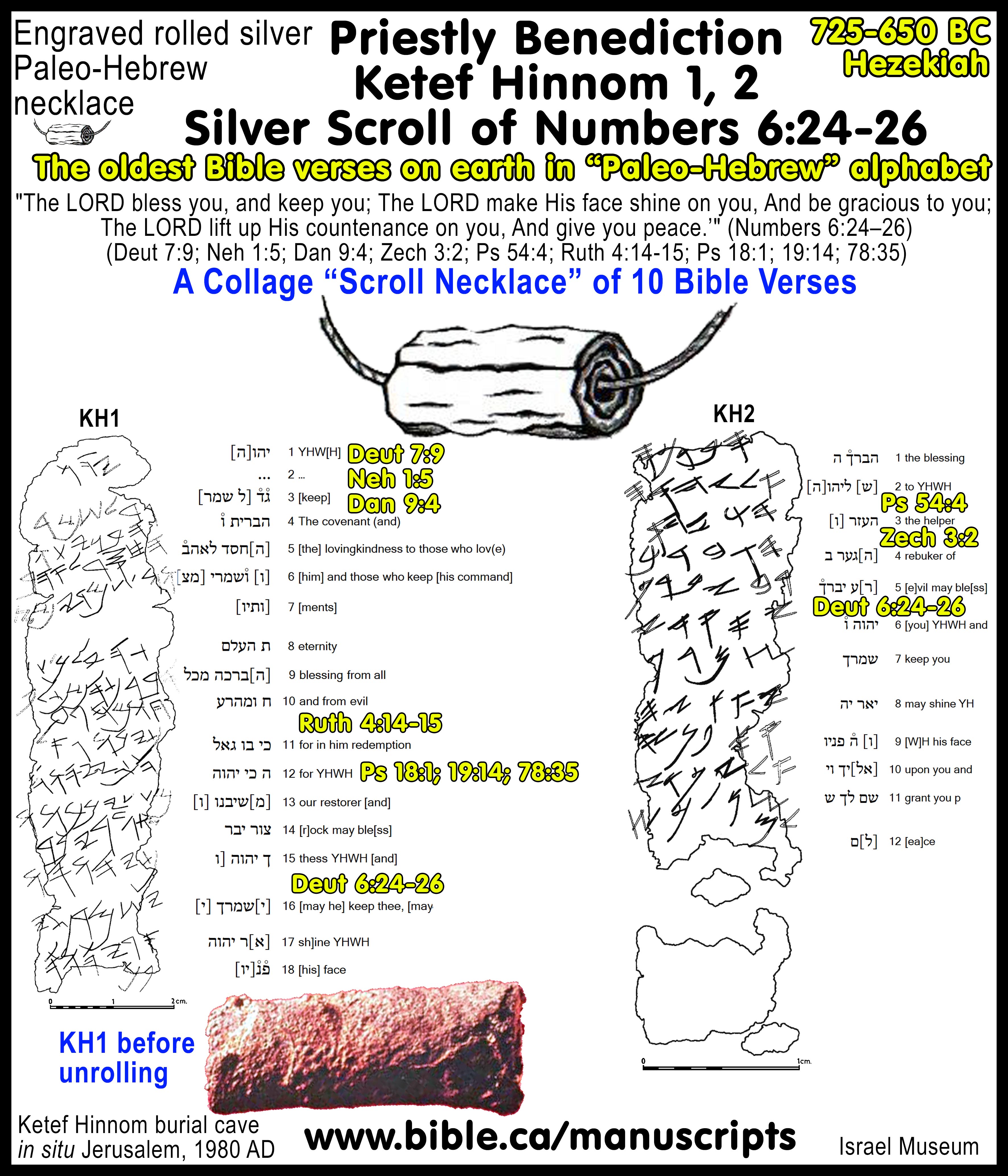
b. Aramaic-Hebrew (Square Hebrew) is the script of the Dead Sea scrolls and in Jerusalem today.
2. Ezra is the only possible candidate to convert the Paleo-Hebrew bible manuscripts into Aramaic-Hebrew script:
a. The need: Hebrew was extinct as a working language and the Jews spoke Aramaic and were familiar with the Aramaic alphabet script. Substituting the Aramaic alphabet for the Paleo-Hebrew alphabet would bring the manuscripts up to date.
b. The opportunity: Ezra was both a scribe and a priest who lived from the Decree of Cyrus in 536 BC down to the New year of 1 Tishri 445 BC.
c. The Zeal and restoration: Ezra zealously devoted himself to study the word of God and restored the feast of booths, enforced the prohibition of marrying non-Jews etc.
d. The introduction of public Torah readings: In 445 BC Ezra build a little wooden podium where the 14 translators flanked either side of Ezra. It was there that the new Quattuordecim (XIV) Aramaic-Hebrew Bible was unveiled for the first time to the world.
3. Ezra Died in 445 BC at 120 years old:
a. Ezra the priest/scribe must have been over 30 years old in 536 BC because that is the age priests must be to serve. (Numbers 4:3, 23, 30, 35, 39, 43, 47) 90 years had elapsed from the decree of Cyrus in 536 BC to the unveiling of Ezra’s Quattuordecim in 445 BC.
b. He unveiled his Quattuordecim in 445 BC when was about 120 years old.
c. There is a synchronism between Ezra and Joshua living to be 120 years and the keeping of the Feast of Booths.
d. Notice that 445 BC under Ezra, was the first time since Joshua, almost 1000 years earlier, that the entire nation celebrated the feast of Booth. (Solomon instituted the feast of booths, but it was only kept in Jerusalem, not the entire nation: 2 Chr 7:8; 8:13)
4. The Variants between the Samaritan Pentateuch (SP) and the Hebrew Quattuordecim (XIV) are best explained as a Jewish anti-Samaritan editing scheme by Ezra.
a. On two different historic occasions, the Jews corrupted their own Bible to counter theological adversaries. The Jews in 160-200 AD corrupted the Genesis chronology for anti-Christian purposes unknowingly following in the footsteps of Ezra in 458 BC who, for anti-Samaritan purposes, changed the location of Joshua’s alter from Mt. Gerizim to Mt Ebal as he converted the Paleo-Hebrew Tanakh into Aramaic Hebrew. Noah got drunk, Moses struck the rock, David committed adultery. Perhaps this one textual corruption was Ezra’s great sin. Notice that in historic both cases of 458 BC and 160 AD, the entire collection of Hebrew manuscripts were entrusted into the hands of a small number of men who created a single “autograph manuscript” that would come to dominate the world, all within a Jewish population who were Hebrew illiterate and would be unable to detect the changes.
5. Continue reading to Ezra’s Variant: Deut 27:4: Joshua’s Altar on Mt. Gerizim
In the final analysis, we can be certain that we possess the word of God!
This is what Jesus meant, when He said: "Scripture cannot be broken" (Jesus, John 10:35)
"My word will accomplish what I desire and succeed in the purpose for which I sent it." (Isa 55:11)
|
The Septuagint LXX “Scripture Cannot Be Broken” |
|||||
|
Start Here: Master Introduction and Index |
|||||
|
Six Bible Manuscripts |
|||||
|
1446 BC Sinai Text (ST) |
1050 BC Samuel’s Text (SNT) |
623 BC Samaritan (SP) |
458 BC Ezra’s Text (XIV) |
282 BC Septuagint (LXX) |
160 AD Masoretic (MT) |
|
Research Tools |
|||||
|
Steve Rudd, November 2017 AD: Contact the author for comments, input or corrections |
|||||
By Steve Rudd: November 2017: Contact the author for comments, input or corrections.
Go to: Main Bible Manuscripts Page
